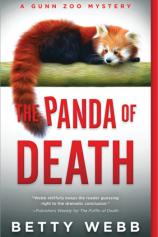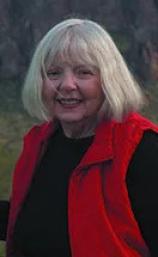Author Talk: March 5, 2020
After wrapping up her 10-volume series featuring Scottsdale private eye Lena Jones last year, Betty Webb has resumed her Gunn Zoo Mystery series with the sixth entry, THE PANDA OF DEATH, which is now in stores. In this interview, Webb talks about how she decides which animal will be the key element in each of these novels, the premise of her new series and why she enjoyed doing the research for the opening installment, the authors whose works can be found on her nightstand, and the one aspect of the publishing industry that she considers to be an improvement over the state it was in when her first book came out in 1976.
Question: THE PANDA OF DEATH is the sixth book in the Gunn Zoo Mystery series. For many years, you had been alternating between writing this one and your Lena Jones series, which ended last year with volume 10. Does it feel odd to be working on only one series now?
Betty Webb: Ah, but I’m not! I’ve already finished the first draft of a book that’ll head up a historical series set in France. So as far as work goes, other than a lot of damp Parisians instead of sunburned Arizonans --- quelle différence! --- things are pretty much the same. Write. Rewrite. Rewrite again. And maybe even again.
Q: The link among the novels in the Gunn Zoo series is having a different animal be a key element in the plot each time. How do you decide which animal needs to be integrated with the mystery plot each time?
BW: I’m a volunteer at the Phoenix Zoo, so the star of any one book is generally an animal that I enjoyed being with on a particular day. Animals are like people, you know; they’re all different. This time around, however, I used an animal --- a red panda --- who I met during a visit to the San Francisco Zoo. It was love at first sight, and I wanted so badly to take her home, but they wouldn't let me.
Q: The Gunn Zoo series is generally viewed as part of the cozy mystery category, while your Lena Jones series was pretty hard-boiled, with very violent crimes and traumas involved. How difficult was it for you to shift tonal gears between your approach to writing each series?
BW: It was very difficult, especially during the first few chapters after a switch. For instance, Lena Jones, a stone-cold pessimist (she was raised in foster homes), is physically rough, whereas Teddy, my zookeeper heroine, is a light-hearted, people- and animal-loving person. So what frequently happened when I went from writing Lena to writing Teddy was that the first few chapters tended to have Teddy behaving in a vicious, Lena-like manner, and I had to rewrite them. The same thing happened when I switched from sweet Teddy to rough Lena. The first few chapters showed an easygoing Lena who couldn’t shoot her way out of a paper bag.
Q: What can you tell us about the new series that you alluded to earlier?
BW: The first book in the new series (still in the writing stage) is LOST IN PARIS, set in France between the wars. My heroine is American artist Emma Barlow, whose past is decidedly murky. Due to her own traumas and moral conflicts, she finds herself among the roughest of Parisians and has to shoot her way out. Since I’ve always adored Paris, I am loving the on-site research!
Q: Do you read any mystery authors for pleasure when you’re not writing? Who among your contemporary crime writers might be found on your nightstand? And who among those from earlier times?
BW: I’d say that 75% of my reading is mystery and suspense --- with the remaining 25% considered to be “literary” fiction. As to who’s on my nightstand, here are just some of my favorites: Kate Atkinson, Peter Robinson, Nevada Barr, Stephen King, Dean Koontz, Jenny Offill, Chuck Wendig, Ann Napolitano, John Green and Nicola Yoon. You’ll notice that there are a couple of YA writers in there, so my math is obviously off.
Q: Having taught writing for many years, in addition to having been on staff as a newspaper journalist, what is the most galling problem you see mystery authors make in their books?
BW: Ah, the list is so long. But this is what I see most often with rank beginners (those not yet published): Their manuscripts usually show that they’re not reading enough, so they don’t know what’s already out there. Therefore, their plots are stale, their characters stereotypical, and their styles so long-winded that they need to be locked in a room for a year with nothing to read but Hemingway novels.
Q: Is there anything about the publishing industry today that you feel is actually an improvement over the state that publishing was in when your first book came out?
BW: My first novel released in 1976, but it wasn’t a mystery. It was one of those autobiographical things I believed was the kind of serious art that would earn me a Nobel, but my publisher positioned it as a feminist comedy. Reviews were lukewarm.
My first mystery, DESERT NOIR, didn’t come out until 2000, after I’d had all that artsy, self-important posturing knocked out of me during my years as a journalist. But in a way, I still prefer the Good Old Days, when most publishers weren’t huge, offshore conglomerates.
As for what I think is an improvement, I much prefer today’s crazy-wild book covers to the drab covers of yore. And here I have to give a tip of the hat to Nicola Yoon’s EVERYTHING, EVERYTHING, Erika Swyler’s LIGHT FROM OTHER STARS, and Luke Rhinehart’s INVASION.




